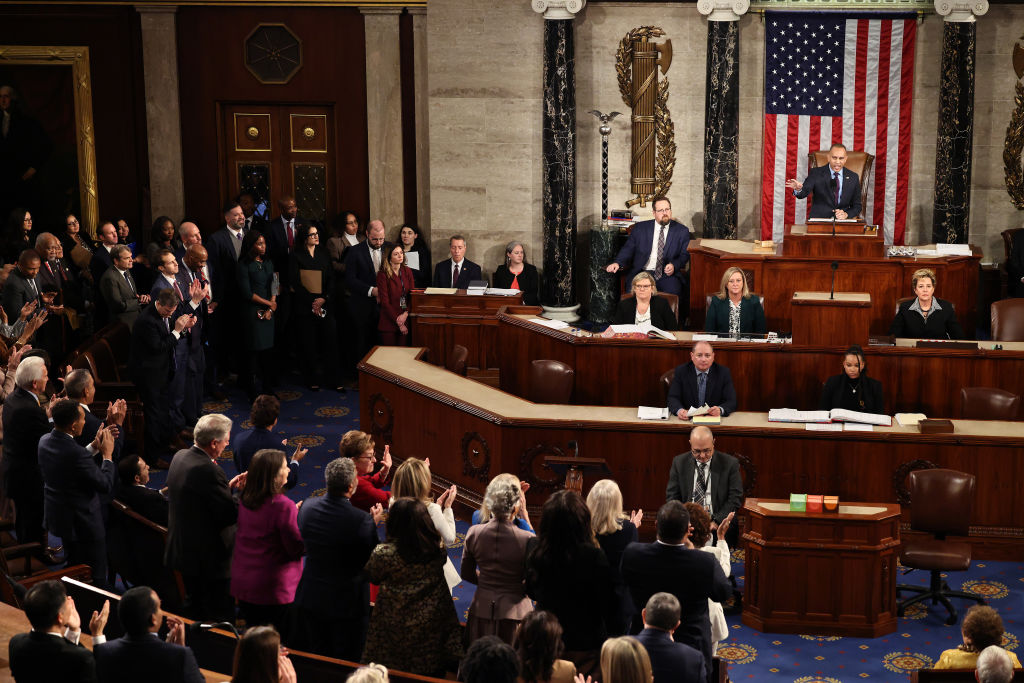Recently, the United States has fully unveiled a new initiative under President Trump called Golden Dome – a missile defence project of unprecedented scope and ambition. Originally included among Trump’s flurry of Executive Orders in January as an American version of Israel’s Iron Dome, it has since changed names and is envisioned to be much, much bigger. It is intended to provide security for the entirety of the United States homeland, but it will have global coverage – because the US can be targeted by long-range missiles, including intercontinental ballistic missiles, launched from any point on the globe.
Golden Dome is intended to be a family of systems – some, based on the ground – but centred around a space-based architecture. It would deploy interceptors in orbit capable of being fired from space to intercept enemy missiles during their intra-atmospheric course. These are essentially airborne targets. But once the principle is established that you can target an airborne threat from orbit, a Pandora’s Box opens: why not strike a ground-based target, or a naval target, from space?
This is the beginning of a new era in space warfare. For the first time, the United States has made it its policy to place weapons in space that can conduct space-to-Earth strike – effectively, and eventually, bombardment from orbit. To channel President Trump’s inimitable style, this is HUGE. It is going to be a major departure for US space policy – an expensive programme, with massive industrial and strategic repercussions.
Golden Dome also raises foundational questions for international security. The principle of the “peaceful use of outer space” has long been front and centre in international space diplomacy and agreements since the first US-Soviet Space Race in the 1960s. But the legal framework is narrower than many assume. The Outer Space Treaty of 1967 prohibits weapons of mass destruction – namely nuclear weapons – in orbit. It does not prohibit conventional weapons. During the Cold War, there were numerous tests of conventional weapons for space intercept and other offensive military operations. In recent years, China, Russia, and India have all conducted direct-ascent anti-satellite (ASAT) missile tests from the ground. So the taboo against space weaponisation has always been more normative than strictly legal.
The longstanding fear has been that once someone starts deploying weapons in orbit, especially weapons which could strike targets on Earth, it would represent a very destabilising step – one that could impact strategic stability and lead to a potential arms race in space. That concern, together with the sheer financial cost attached, has been strong enough to keep major powers from going down that road. But the strategic environment has changed, and technology has advanced, making old ideas finally more feasible. Geopolitics, especially, have shifted massively. The behaviour of adversaries – especially China and Russia – has become far more concerning.
Long-range missile technologies, especially hypersonic systems, are now coming online in increasing numbers. Defence planners are looking to the future and seeing – anticipating – whole arsenals of these weapons being built and placed in the hands of potential adversaries in the coming years and decades. A credible defence against long range strike campaigns is now becoming a national priority, and must start in space. The essential component for defending against advanced missile threats is space-based. Only from space, from an orbital vantage point, can one detect and track such threats globally, in real time, and direct interceptors against them accurately and rapidly.
Golden Dome is not just a Trump fad or gimmick. It hearkens back to the Strategic Defence Initiative under Ronald Reagan – known popularly as “Star Wars.” Reagan’s idea was similar: to build a space-based missile defence system that would alter the strategic nuclear balance in America’s favour. The premise was that if one side could prevent a full retaliatory nuclear strike by the enemy (by intercepting some of his ICBM salvo), mutual assured destruction would no longer hold. The enemy’s deterrence calculations would be defeated. The Soviets, realising they could not compete with such a potential US missile defence capability, faced enormous pressure. Some argue that the threat Star Wars presented – even though the system was never actually built – played a decisive role in the eventual collapse of the Soviet Union.
Today, however, the technology that the Reagan Administration scoped out for Star Wars has actually matured. Key enabling capabilities – from AI-driven data processing to reusable launch systems – have become operational. SpaceX has revolutionised launch economics, making the deployment of large-scale orbital architectures far more feasible. A significant part of the vast projected cost of Reagan’s Star Wars was the launch; today, that barrier has fallen dramatically.
In addition to Golden Dome itself, which represents a warfighting capability, the United States is also undergoing a doctrinal shift with respect to the space domain. In recent weeks, two new documents were released by the US military: a new Space Force doctrine and a Space Warfighting framework. Together, they signal a historic pivot. The Space Force now sees its core mission as achieving space superiority and defines itself as a combat service. Its primary purpose is, explicitly, not to support terrestrial operations – but to conduct space warfare.
This represents a 180-degree turn from the previous dispensation. The Biden administration, and allied countries closely aligned with it, took a much more liberal and normative approach to space policy and doctrine – focusing on international rules, norms of behaviour, arms control, and legislative initiatives. The 2022 UK Defence Space Strategy, for example, did not mention words like “war,” “combat,” or “warfighting” even once.
But the context has changed dramatically. The United States is no longer just defending space assets. It is preparing to use space as a domain of active warfare – and not just for self-defence, but for terrestrial strike from orbit. The consequences of this shift will ripple far beyond Washington and US defence policy.
Adversaries are watching closely. Early reactions have already emerged. Moscow has warned publicly against the effects of Golden Dome on strategic stability. Beijing has echoed this concern. Their argument is clear: a functioning space-based missile shield would disrupt the principle of mutual assured destruction, thus undermining strategic stability. Again, if the United States can intercept a nuclear salvo in flight, the adversary might not be able to launch a counterattack. And this is precisely how that nuclear balance is broken.
Strategic stability has long been one of the most fundamental pillars of international security. If and when Golden Dome actually becomes reality, Chinese and Russians will use this argument – likely to maximum effect – to try to deter the United States from moving forward. But the Americans see it differently: Golden Dome is a response to a gradual escalation in Russian and Chinese counterspace capabilities over the past decade and more. It is a reply to their increasingly aggressive behaviour.
Of course, now that the United States is taking action, the response is one of protest. But that is often how international security operates. The military balance is evolving – and space is becoming its indispensable component.
At present, neither Russia nor China possesses advanced space-based intercept capabilities such as those envisaged for Golden Dome. Intercepting an ICBM in its boost phase from orbit is immensely difficult. It requires detection, dispatch of an interceptor, and a successful strike – all within a four to five minutes window while the missile is still burning through its first stage. At that point the missile is vulnerable and clearly visible from space, but the technological and timing demands of making this intercept kill-chain work are extreme.
Moreover, the launch capacity required to deploy such systems – particularly reusable launch – is not yet fully within China or Russia’s grasp. The Chinese are advancing rapidly and may perfect systems mimicking Elon Musk’s Falcon 9 rocket, and even Starship, in the coming years. But the current technological edge remains with the United States.
This will not last forever. It is almost certain that China, and possibly Russia, will seek to respond to Golden Dome and to Space Force’s broader shift to a more offensive posture. Whether they do so symmetrically or asymmetrically remains to be seen. Golden Dome is expensive – initial official estimates suggest costs may reach $175 billion, with $25 billion proposed in initial funding and awaiting Congressional approval. That scale of required investment may deter an identical response from adversaries. But asymmetric counters – cyber and electronic warfare attacks, kinetic ASATs, or close-in attack satellites – could offer other pathways to contest US space superiority.
The implications for Western allied nations are profound. Many have relied on American space capabilities for everything from communications to targeting. But the formal shift in US doctrine now places space warfare at the centre of future conflict: both in terms of in-space combat, and in terms of space-to-Earth strike. Allies will need to adjust their own postures, investments, and doctrines to remain interoperable and secure.
Golden Dome signals the beginning of a new phase in strategic competition – one where the classical domains of air, sea, and land will, for the first time, become subject to increasingly decisive power projection from the “ultimate high ground” in orbit. Those nations that understand this, and build up their space capabilities, will be the winners of the 21st century.






Would Trump defend Taiwan?